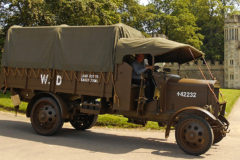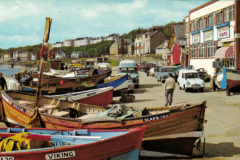My special Commer Paralanian
Posted by Chris Graham on 16th July 2020
Mike Neale meets up with a rather special Commer Paralanian, which is now in highly appropriate ownership for a Rootes Group product.
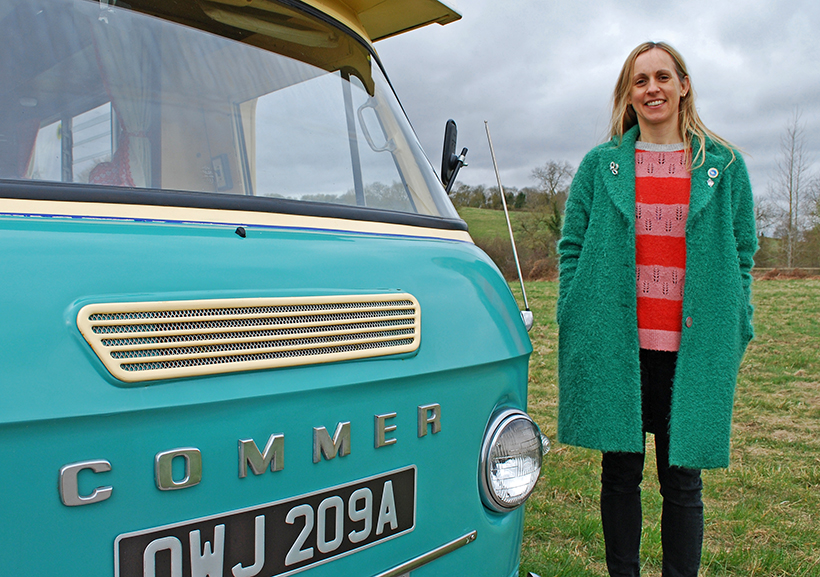
A special Commer Paralanian: Owner Talitha Hart – William Rootes’ great grand-daughter – with her beloved Commer. Separate chrome letters replaced the red, ‘Commer’ nose badge from 1963, the year this van was built.
The first ‘Paralanian’ Campers were built in 1957 by Central Garage Ltd. of Parry Lane, Bradford, the street name inspiring the choice of the brand name. The company had been an Austin dealership for many years and so the first and, indeed, most subsequent, Paralanian campers, were based on the Austin 152/J2 van.
The Mk1 and Mk2 of 1958 both had a squarer rear, but more rounded frontal bodywork above the cab, that ended flush with the windscreen, similar in appearance to the contemporary Bluebird Highwayman, compared to the more commonly-encountered Mk3, launched in late 1961.
Coach-built body
The coach-built bodies featured an arched roofline, making for fantastic headroom inside, and a single door at the rear, fitted with ventilation louvres. The curved-under bodywork at the rear is a particularly distinctive feature of the Mk3 Paralanian design. Early Mk3s had a canvas covered roof. Internal fittings were of a high quality, with these vehicles aimed at the luxury end of the motor-home market. The rear body was built of ash, while the interior fittings were of French-polished walnut, with an Axminster carpet on the floor.

A sink is concealed under a lift-up flap. Sadly, the original, Axminster carpet floor covering is long-gone.
A chemical toilet was housed in the rearmost, right-hand compartment, as well as gas bottles for the adjacent, two-burner hob and oven/grill; the latter hidden behind a pair of doors when not in use. On the left was a full-height wardrobe in the rear corner, with the sink next to it.
Forward of this were the dining table and seats which, of course, folded down to form a double bed. A small, single bed could be formed across the front of the cab, by laying down the padded seats.
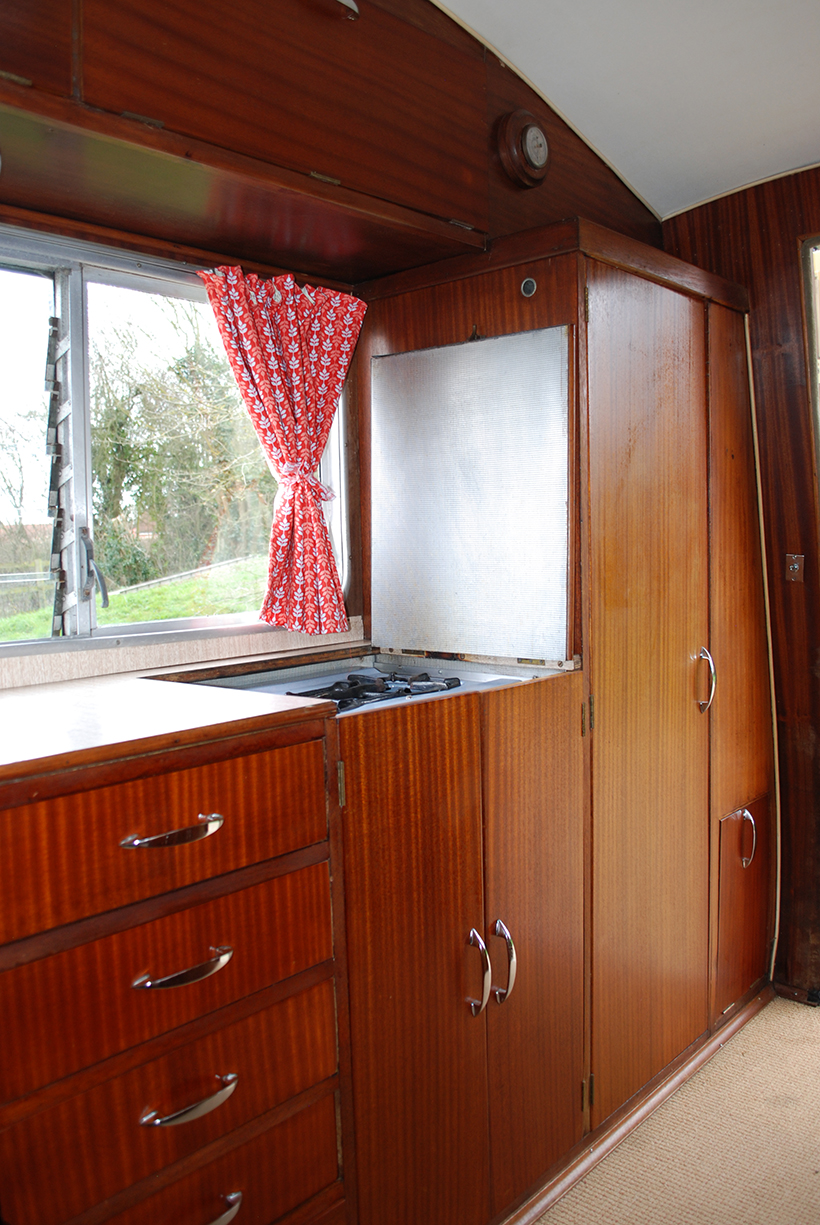
The rear compartment conceals the toilet which, understandably, has been upgraded to a modern unit.
A small number of Paralanians were also built on the Morris J2 and Commer 1500FC/PA chassis. Central Garage had been building its motorhomes for almost three years, before Commer launched its ¾-ton van in January, 1960. The new van featured independent front suspension with double wishbones, coil springs and telescopic dampers. At the rear, semi-elliptic leaf springs were provided, with lever arm dampers. The narrow track meant that the wheels were tucked well under the bodywork, especially at the front. A new gearbox had synchromesh on all four, forward gears.
A special owner
Now owned in Suffolk by Talitha Hart, Mildred is believed to be the only surviving Commer Paralanian. Talitha worked in London for many years and didn’t own a car. “I’d always dreamt of having a Rootes Group vehicle, though,” she told me. Why might this be, you may be wondering?
Well, there’s actually a very good reason. Before she married, Talitha Hart was Talitha Rootes, and she’s the great-grandaughter of Sir William Rootes. The very same Sir William – better known as Billy – who, with brother Reggie, set up the family car distribution business in 1917, which subsequently took over vehicle manufacturing firms including Humber, Hillman, Commer and, later, Karrier, Sunbeam and Singer, becoming the Rootes Group. Talitha and her sister, Annabel, are the last of the Rootes family line.
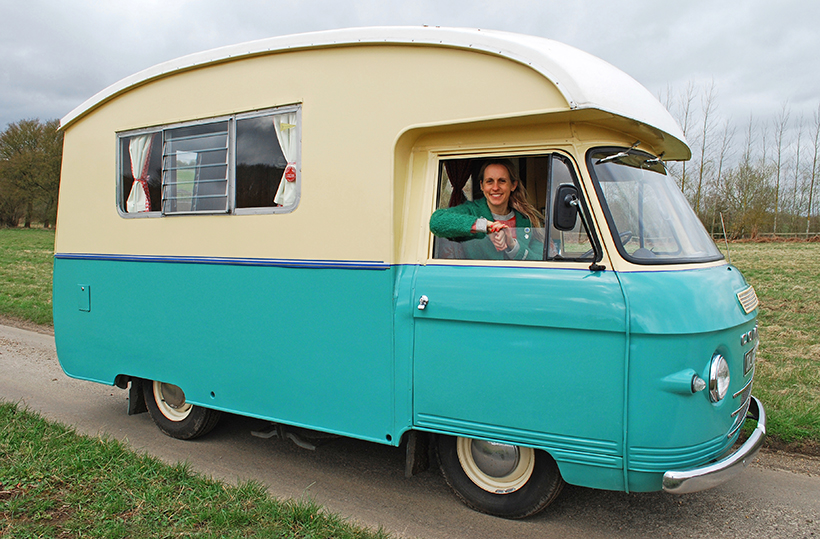
Now owned in Suffolk by Talitha Hart, ‘Mildred’ is believed to be the only surviving Commer Paralanian.
When Talitha told her family that she was looking for a Rootes vehicle, they were expecting her to go for something like a sporty Sunbeam Alpine or, maybe, a luxurious Humber. Her husband, Charlie, said: “I quite fancied a Humber Super Snipe Estate, or even a Humber Pig.” So her final choice was more of a surprise to the family, although it is much, much rarer. Talitha explains how this came about.
“A few years ago, Peugeot, which owned the old Rootes factories, announced that it had a whole corner of the factory that was full of filing cabinets stuffed with Rootes archive blueprints and documents, which needed to be rescued or they’d be dumped. Fortiunately, a group of enthusiasts quickly mobilised and saved them, forming the Rootes Archive Centre Trust.”
Opening event
“My father, Bill Rootes, my sister and I were invited to the opening of the Trust’s new building in Wroxton. Dad still had the old Rootes HQ boardroom chairs from Devonshire House, on London’s Piccadilly, which he donated to the Trust. At the opening event, I was asked to choose my ‘best car of the show’ and, rather to the annoyance of my father, I picked a Hillman Super Minx convertible, rather than one of the older or rarer cars in attendance.
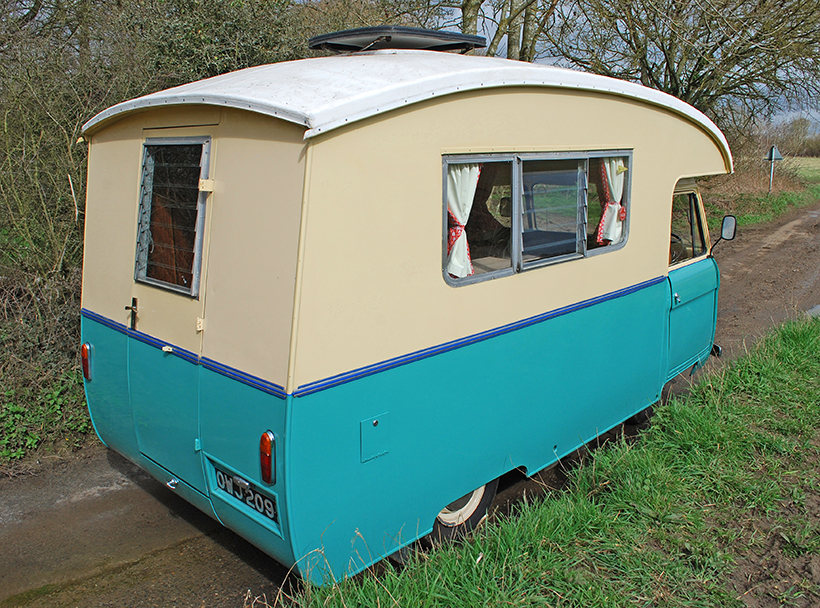
The coach-built body featured an arched roofline, making for fantastic headroom inside, and a single door at the rear, fitted with ventilation louvres.
“Until then, I hadn’t realised that there was such a thing as a Commer Camper, which got me thinking. One would be ideal for our lifestyle…” So, who should she approach to find such a vehicle? The answer of course was ‘Mr Commer’, Martin Maltas, who used to both restore and own a huge (although now somewhat reduced) collection of Commer PA/PB and Dodge Spacevans. Martin still specialises in parts and remanufactured body panels, through his website commervanspares.co.uk.
Talitha met Martin at a Commer gathering at Tendring Hall, in Essex, and subsequently visited his workshops in October 2018, where she saw and fell in love with ‘Mildred,’ despite her looking very down-at-heel (Mildred that is, not Talitha…).
Martin takes up the story. “I’ve known ‘Mildred’ the Paralanian for some years, it was owned by Dennis and Marge from near Hull, for around 20 years. Seven or eight years ago, I rebuilt the roof. Dennis had replaced the original fabric covering twice in their ownership, but it always leaked again. Some of the aluminium panel work was done, as well.”
Out of their depth
“As I’d stopped restoring them, Dennis took Mildred to a bodyshop in Hull to restore the cab. Rotten panels were stripped off and the firm quickly realised it was out of its depth with the vehicle, so there is stood for over 12 months. Sadly, Dennis died before anything could be done, and Marge asked if I would like to buy it because she knew I’d bring her back to life.
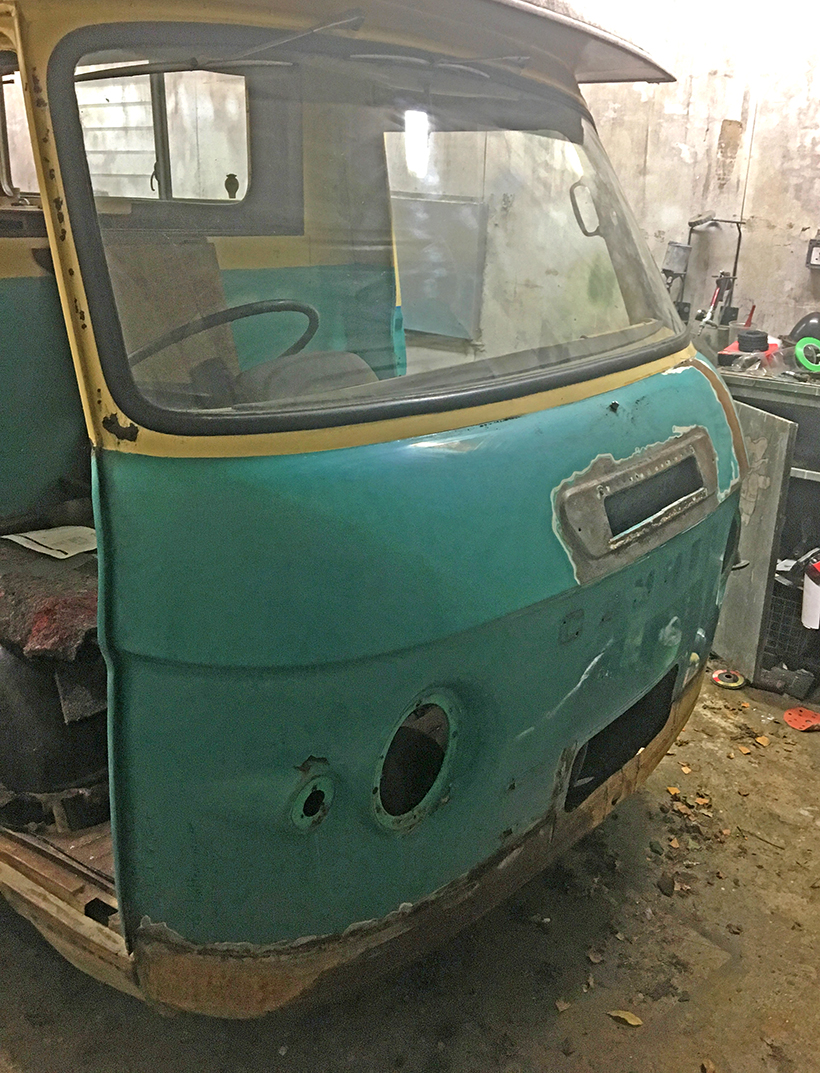
The camper, as first seen by Talitha.
“Talitha purchased her and asked me to restore the cab. I also did a few upgrades, including fitting a four-branch exhaust and SU carb set-up that I manufacture.”
Talitha pressed Martin to get Mildred ready by Easter 2019, as the whole of her family were coming to visit, and she wanted to show them her new acquisition. Fortunately, Martin got her there in time.
Since then, Charlie has done some further work on the 1,592cc Hillman Minx engine, which was ticking over very sweetly when I visited. New memory foam was bought for the mattresses. Talitha’s mum gave her the old picnic hamper which was a period accessory from the Rootes family’s Humber Super Snipe Shooting Brake “It includes a whisky bottle, which was, of course, essential for long drives in those days!”
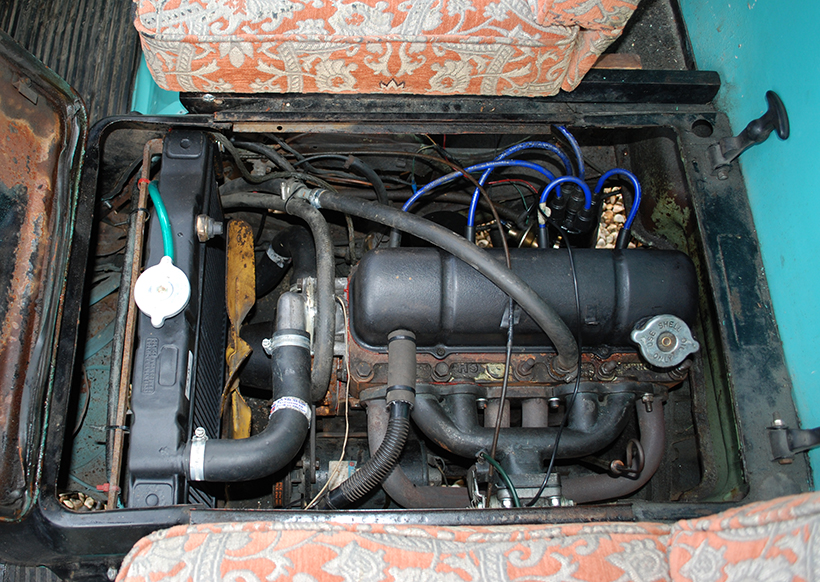
The ‘Standard’ Rootes 1,592cc engine was also used on contemporary Hillman and Singer cars.
There are ongoing bits of work to do, such as a few minor rust repairs and bits of filler that need sorting out, plus they may paint the fibreglass top. Talitha took some photos of a set of original concertina wooden shutters on an Austin Paralanian at Goodwood, which are missing from Mildred, as she plans to have a set made to replace the front curtains. The only modern addition is a replacement Italian loo in the original cupboard.
On the road
So, what is she like on the road? “Well, 35-40mph is a good cruising speed! The engine is much happier on B-roads than A-roads, and we don’t go on motorways. You get a lot of buffeting from the wind and passing vehicles. Getting buffeted by a motorbike was a new experience!” laughs Charlie.

This picnic hamper came from Talitha’s mother, and has real Rootes family heritage, having originally been carried in the family’s Humber Snipe shooting brake.
“She is very comfortable to sleep in, and you can stand up inside everywhere,” adds Talitha. “We go to the Latitude Festival with the kids, along with friends who have VW Campers, but Mildred knocks their socks off! She sleeps three, although the third person needs to be quite small, but it’s fine for my son, at the moment. She’s also good for going around to friends’ houses for dinner, although they might not think so, as we can drink their wine and just stay over in Mildred!”
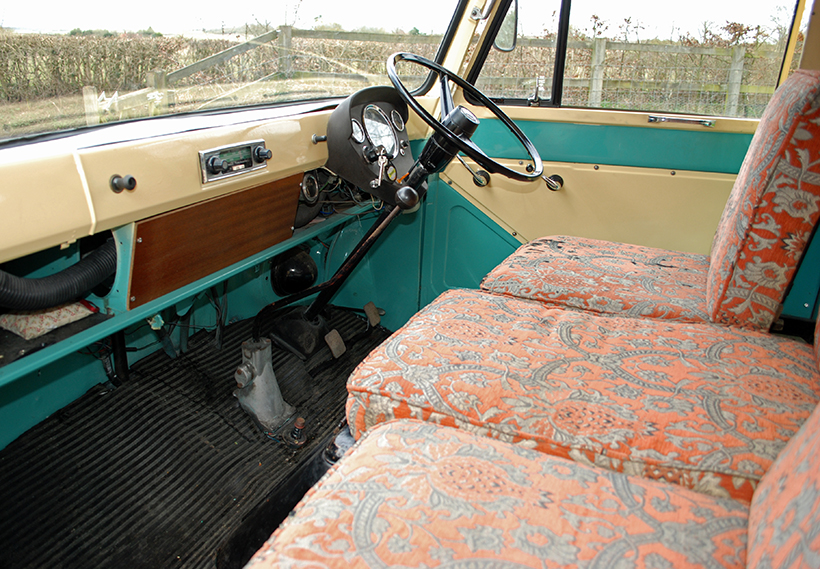
The front seats can be used as a small, single bed. A comfortable cruising speed for this early 1960s Commer is 35-40mph, so it’s happiest on B roads.
Mind you, their first holiday in Mildred didn’t go quite as planned. As Cornwall is a long way from Suffolk at 40mph, they decided to tow her there behind their modern Land Rover Discovery. Unfortunately, that broke down and was loaded on to a recovery trailer, so they pressed on in Mildred… which also then broke down. They did get her to their holiday destination, however, but came back with the AA.
“Luckily, I married a man who is also interested in cars and the Rootes history,” notes Talitha. There’s another family connection between Talitha and husband Charlie. During the war, Winston Churchill set up the Ministry of Aircraft Production, to get the industry up to speed for the Battle of Britain, headed by Lord Beaverbrook of Express Newspapers. It was based in ICI House, on Millbank, in London.
Wartime colleagues
On the committee were Talitha’s great grandfather, Billy Rootes, to deal with aero-engines, and Bill Stephenson, then chairman of Woolworths in Britain. He was Charlie’s great grandfather. The two Bills were thus wartime colleagues. Of course, Rootes provided a vast contribution to the war effort, including building a large number of aircraft engines.
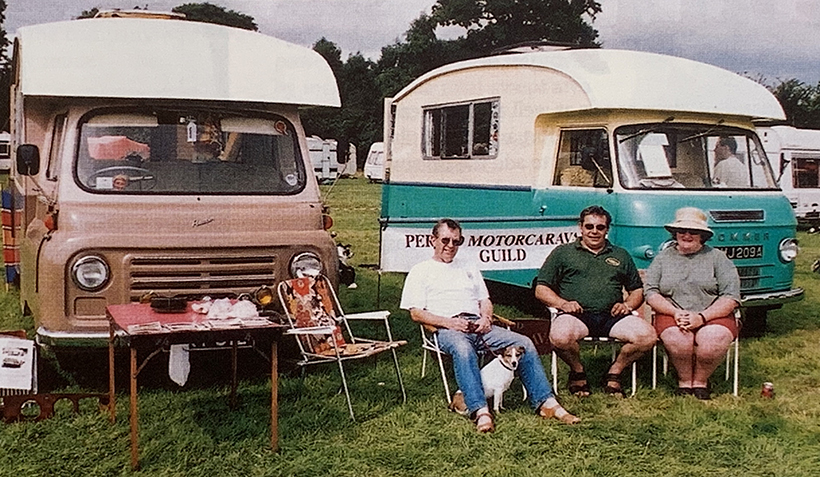
Tabitha’s camper has been in Classic Van & Pick-Up before; this photo of it appeared in first issue with, on the left, then-owner, the late Dennis Jackson.
“My great grandfather’s comments dismissing the Volkswagen Beetle are legendary, and have slightly haunted the family,” notes Talitha. Billy Rootes was one of a number of British, American and French car manufacturers invited to visit the Wolfsburg factory at the end of World War II, describing the People’s Car as too ugly and too noisy, and suggesting that building cars there was a foolish idea. He was far from alone in this view, however.
Talitha grew up on a smallholding that her dad bought on the Rootes family’s estate in Scotland. Billy Rootes had bought the 16,000-acre Glenalmond estate in Perthshire in 1946, containing grouse moors and lochs, with a large country house at its centre, leaving it to his eldest son Geoffrey when he died. The estate gives its name to the Glenalmond Green colour used on Rootes Group cars, including of course the Scottish-built Hillman Imp.
One of the first Rootes events that Talitha attended was the Imp 50 rally in Perth, in August 2013. All the cars drove out from Perth Racecourse to Glenalmond House. “It was an impressive sight, seeing hundreds of Imps all lined up in front of the house,” recalls Talitha.
Celebrated history
“When I was little, the Rootes history wasn’t talked about that much, perhaps partly because both children were girls, but also because there was a sadness that it had all gone. My dad, Bill, had expected to go into the family business when he was growing up, but it was sold to Chrysler and, finally, it was no more. However, more recently there’s been something of a turnaround, with the family wanting to celebrate it rather than being sad about it. Since I bought the Commer, the current Lord Rootes, my father’s first cousin, has bought a 1954 Sunbeam Alpine.” As it’s a hereditary peerage, which passes only to a male heir, the present Lord Rootes will be the last.
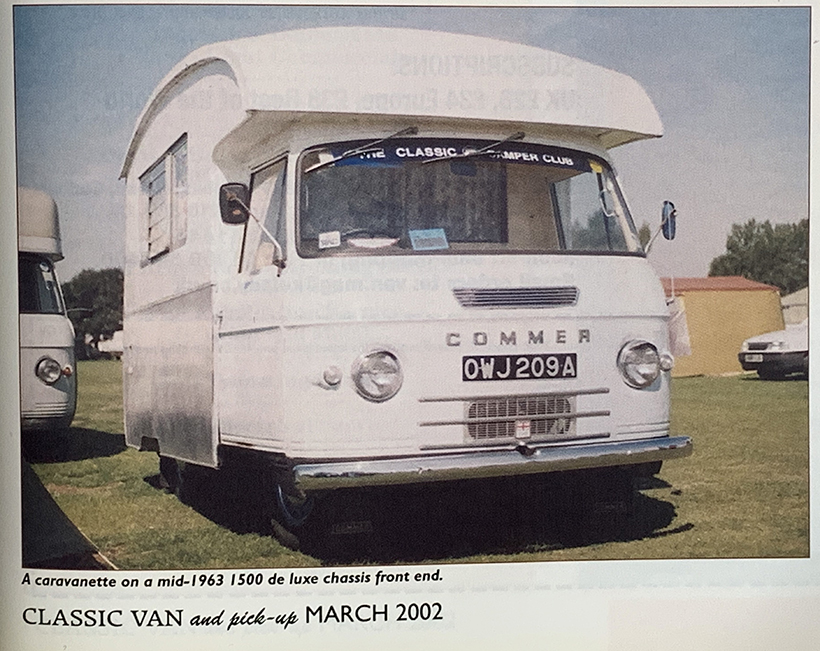
It also appeared in 2002, sporting white and grey paintwork. Did it wear this colour-scheme between coats of turquoise and cream, or was the photo published in 2002 actually taken earlier?
Just before meeting Talitha and Charlie, I came across a couple of photos of Mildred the Paralanian in old issues of Classic Van & Pick-Up magazine, which has actually exposed something of a mystery. In the very first issue of November 2000, Mildred appears in her current turquoise and cream colour scheme. However, there’s also a photo of her in off-white, with pale grey lower rear side panels, in the March 2002 issue. Did the colour change over that two-year period, before changing back again, or was the second photo actually taken earlier? “We’d thought that turquoise and cream were her original colours, but perhaps this isn’t the case,” ponders Talitha. Original or not, the colours certainly suit the van.”
So, this rare Commer has come full circle, built by Rootes and now back in Rootes family ownership. Mildred is one of the family, and is definitely a keeper. “Although, if I won the lottery, I might add an early Sunbeam Alpine to keep Mildred company,” admits Talitha.
For a money-saving subscription to Classic & Vintage Commercials magazine, simply click here



